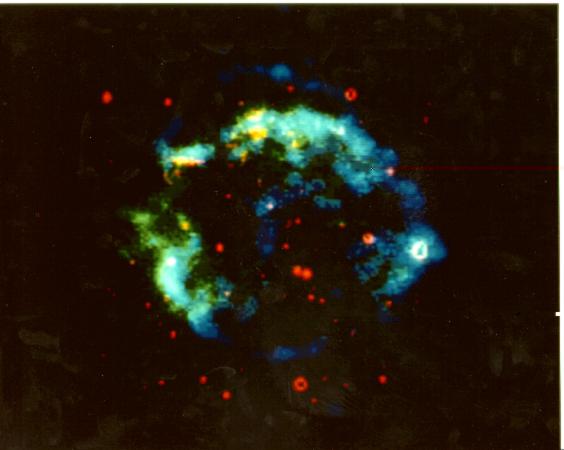
Three wavelength image of the supernova remnant Cassiopeia A, the remains
of a star that exploded about 1680. The x-ray image (shown in green)
represents very hot gas at about 10 million Kelvin heated by the shock waves
accompanying the supersonic expansion of exploding star moving out into its
surroundings at about 20 million miles per hour. The red represents optical
emission from cooler, denser clumps of gas at about 10 thousand Kelvin
immersed in the hotter gas under pressure balance. The blue is radio
synchrotron emission from relativistic electrons accelerated by the strong
magnetism of this supernova remnant. By studying all three together we can
learn in detail how the material expands and interacts with its surroundings.
John R. Dickel

Adjunct Professor
Ph.D., University of Michigan, 1964
johnd@phys.unm.edu
I
study supernova remnants both observationally and theoretically to detail the
interaction of the expanding blast with the surrounding interstellar medium.
By using radio, optical, infrared, and x-ray wavelengths, my colleagues and I
can investigate all the various components of the surroundings to see how
clumping and irregularities affect the expansion.
I am also participating in multiwavelength studies of the Magellanic
Clouds, satellite galaxies of the Milky Way, in order to elucidate the
physical properties of the many components of the interstellar medium in
those galaxies.
I am part of the team building the Long Wavelength Array, an exciting
new radio telescope being constructed by the University of New Mexico, the
U.S. Naval Research Lab., the University of Texas at Austin, and the Los
Alamos National Lab.
Selected Recent Publications:
Dickel, J. R. and Wang, S. 2004, ``Peculiar Synchrotron Spectra in
Pulsar Wind Nebulae,'' in Young Neutron Stars and their Environment,
IAU Symposium, 218, 221
Williams, R., Chu, Y.-H., Dickel, J., Gruendl, R., Shelton, R., Points, S.,
and Smith, R. C. 2004, ``Supernova Remnants in the Magellanic Clouds. IV.
X-Ray Emission from the Largest Supernova Remnant in the Large Magellanic
Cloud,'' ApJ, 613, 948
Dickel, J., McIntyre, V., Gruendl, R., and Milne, D. 2005, ``A 4.8 and
8.6 GHz Survey of the Large Magellanic Cloud. I. The Images'', AJ, 129, 790
Gaensler, B. M., Haverkorn, M., Staveley-Smith, L., Dickey, J. M.,
McClure-Griffiths, N. M., Dickel, J. R., and Wolleben, M. 2005,
``The Magnetic Field of the Large Magellanic Cloud Revealed Through
Faraday Rotation,'' Science, 307, 1610
Williams, R., Chu, Y-H., Dickel, J., Gruendl, R., Seward, F., Guerrero, M.,
and Hobbs, G. 2005, "Supernova Remnants in the Magellanic Clouds. V.
The complex Interior Structure of the N206 SNR", ApJ,
628, 704


